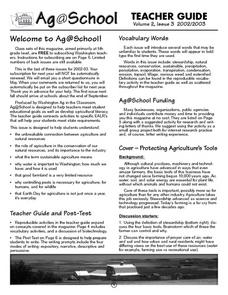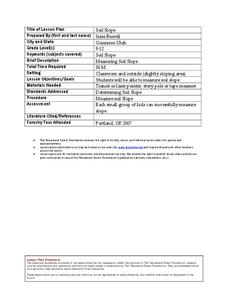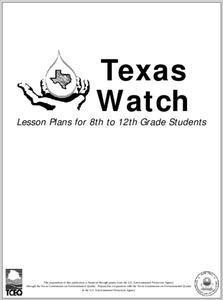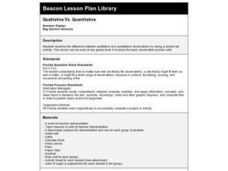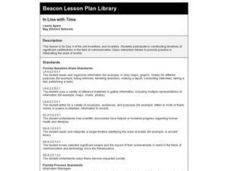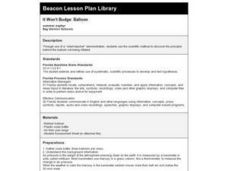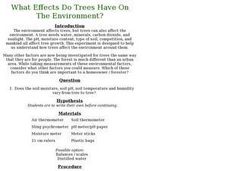Curated OER
Phragmites australis: Invasive Plant Species
Students research and investigate invasive species, with specific focus on the exotic plant Phargmites australis and its impact on Piermont Marsh near the community of Piermont, New York.
Curated OER
Forces and Balloons
Students investigate the forces of compression, tension and torque on common birthday balloons.
Curated OER
Our Solar System: Its Planets and Their Satellites
Fourth graders create a replica of our solar system. Each group arranges the balls in the proper order for our solar system by gluing them to the construction paper. Under each of the balls, the name of the object should be clearly printed.
Curated OER
Lotic Environment
Students assemble a classroom river model as an example of a lotic system. They control and measure biotic and abiotic information for the in-class system and compare data with a lotic system in a natural environment.
Curated OER
Protecting Agriculture's Tools
Learners brainstorm which tools farmers can control and why. They discuss how to conserve water, air and soil. They discuss the role of farmers and how they feed the world.
Curated OER
Soil Slope
High schoolers study how to measure the soil slope of an area. In this soil lesson students work in groups and complete an activity that allows them to find the slope of a given area.
Curated OER
Dog Salmon Lesson Ten
Studnets serve an afternoon tea in order to exhibit the Dog Salmon projects they completed. They take quizzes as a unit assessment.
Curated OER
Superbugs
Students research deep sea communities and discover strategies for combating antimicrobial resistance and write reports on it. They consider overprescription and prophylactic uses of antibiotics as causes for their ineffectiveness.
Curated OER
Something Rotten in West Bloomfield!
Student groups seek a possible ecological problem in the West Bloomfield area then either photograph or videotape the problem. They investigate how to measure the extent of the problem and do it.
Curated OER
Water Quality Sampling
Learners explore the water qualities in Texas. They evaluate the water quality of six different samples by observing and smelling them. They present a list of the cups that contained good water quality based on their observations. They...
Curated OER
Qualitative Vs. Quantitative
Fourth graders examine the difference between qualitative and quantitative observations by doing a simple lab activity. This instructional activity can be used at any grade level. It involves the basic observation process skill.
Curated OER
"Investigating Hazardous Materials"
Eighth graders gather Internet information on a variety of related topics concerning hazardous waste.
Curated OER
Adaptable Animals
Students examine the types of adaptations that animals use to survive. They research the animals and report their findings to the class.
Curated OER
Identifying the Relationship Between Black Carbon and the Weather
Young scholars identify the relationship between black carbon and the weather. In this investigative lesson students compare samples of black carbon with a color-scale and analyze others samples.
Curated OER
In Line with Time
Third graders create a timeline of inventions and inventors made out of light colored bulletin board paper.
Curated OER
Can You Calculate the Speed of Your Pet?
Middle schoolers analyze the formula for speed and velocity. They explore and demonstrate how to calculate the speed of wind up toy pets, average the speeds and identify the correct units of measure of speed.
Curated OER
Construction and Use of an Accelerometer
Eighth graders, in groups, study acceleration and build an accelerometer.
Curated OER
It Won't Budge: Balloon
Eighth graders use the scientific method to discover why a balloon is not inflated.
Curated OER
Barnacles: Harder than Cement
Fourth graders watch the movements of the complex animal hidden inside the tiny barnacle shells. This lesson allows students to study the behavior, adaptation, and larval stage of the barnacle.
Curated OER
Diesel Bus Case Study
Students research the diesel retrofit program underway in Norwich, Connecticut and identify the health risks of diesel fumes - in particular the emissions of fumes from school buses. They outline ways of reducing diesel emissions.
Curated OER
What Effects Do Trees Have On The Environment?
Students examine the interrelationship between trees, soil and people focusing on urban areas. They collect and analyze data about trees in their research area.
Curated OER
The Great Food Hunt
Learners locate 'animals' in various environments and draw conclusions about the survival value of structures the animals possess. They create model macaroni animals and hide them and other teams of students find them and evaluate the...
Curated OER
Manage Soil
Learners identify and classify soil ypes according to data on the soil triangle. Given examples, students identify soil conservation practices, using criterion assessment instrument. When giving a case situation involving soil...
Curated OER
What Makes a Kite Fly?
Ninth graders compare the nature of forces of gravity, lift, thrust, and drag. They select proper materials for making a kite and attach a proper tail. Students interpret and summarize the observations made during the flight of the kites.






